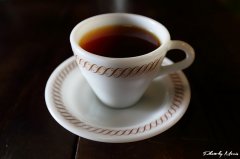The baking degree determines the taste spectrum towards deep roasting, shallow roasting, moderately roasted coffee beans.
Coffee taste spectrum consists of "smell spectrum" and "taste spectrum"; the former directs dry and wet fragrance, while the latter refers to water-soluble taste. The aroma of "odor spectrum" is appreciated by the sense of smell before and after the nose, and the liquefaction taste of "taste spectrum" is captured by the sense of taste. The "smell" and "taste" of coffee often vary with variety, altitude, soil and water, producing area, post-preparation, extraction and roasting degree, but the biggest cause depends on the roasting degree and technology.
The baking degree determines the trend of taste spectrum.
A. "shallow baking": from the middle of the explosion to the end of the explosion, Agtron#75-#66.
Most of the aromatic compounds formed by "shallow baking" are low molecular weight compounds, and the aroma and taste are easy to identify, including sour aroma, herbs, cinnamon, nutmeg, shell, nuts and toast, with the lightest weight and the highest volatility. The flowers of coffee
The sour aroma is the product of "enzyme action", while the smell of shell and bread is the smell in the early stage of Mena reaction in the baking process. The two construct the main taste spectrum of shallow baking.
B. "medium roasting" means Agtron#65-#55 from the end of the first explosion to before the second explosion.
The aromatics of "medium baking" are mainly medium molecular weight compounds with slightly higher mass and moderate volatility, mainly furan compounds (Furan) and pyrazine compounds (Pyrazine), and also have the characteristics of rising into the nasal cavity, which is the mid-term product of caramelization and Mena reaction in the baking process. The aroma is dominated by caramel, cream sugar and chocolate. Although medium baking still has sour flavor, nutty and toast flavor, it is obviously weaker than "light baking".
C. "medium-deep roasting" refers to the violent explosion from the first to the middle of the second explosion, Agtron#54-#40.
D. "Deep roasting" means two exploding tails, Agtron#40-#30.
The aromatics of "medium and deep baking" and "deep baking" are high molecular weight compounds with higher mass than the former two, with low volatility and almost no sour fragrance. They are the products of dry distillation at the end of baking, mainly mercaptan, resin, tar and phenolic compounds, and can be summarized as turpentine, alcohol, tar, choking incense, and the sweet and bitter taste of caramel and caramel.
Three sources, nine charm
After baking, raw beans produce many odors that promote and suppress each other, including fruit, caramel, cream, resin, wine, rice and wheat, stew, pepper, pizza and spice. It is difficult to find a main flavor for coffee
Therefore, the sources of coffee aroma can be divided into three categories: "enzyme action", "sugar browning reaction" and "dry distillation".
a. Shallow baking highlights the "enzyme effect":
1. "Hua Yun", 2. "Fruit Rhyme", 3. "Herbal Rhyme".
b. Medium baking highlights the "sugar browning reaction":
1. "Nut rhyme", 2. "caramel rhyme", 3. "Chocolate rhyme".
C deep baking highlights "dry distillation":
1. "resin rhyme", 2. "Xin Xiang Yun", 3. "charcoal burning rhyme".

Important Notice :
前街咖啡 FrontStreet Coffee has moved to new addredd:
FrontStreet Coffee Address: 315,Donghua East Road,GuangZhou
Tel:020 38364473
- Prev

Tips for the extraction of chilled, cold bubbles and ice droplets
The difference between chilled coffee, cold bubbles and ice droplets using hot extraction to make chilled coffee ice coffee refers to a cold drink coffee that is quickly extracted with hot water and then added with ice or rapidly cooled. It takes about 2 to 3 minutes to make. Using cold extraction to make cold-soaked coffee Cold Brew refers to coffee extracted by soaking coffee powder in cold water less than 5 ℃ for a long time, which takes about 8-12 hours.
- Next
Detailed steps of hand-brewing coffee drinking coffee car boutique coffee beans
The amount of extraction mentioned at the beginning that the ratio of powder to extraction is about 1:20, but that refers to the maximum amount of extraction, so if you do 1: 20:00, the taste of coffee will be relatively much lighter. From the beginning of steaming, coffee particles will begin to absorb hot water and exhaust, about the second to the third time, you will find that coffee begins to be extracted from the filter cup.
Related
- Beginners will see the "Coffee pull flower" guide!
- What is the difference between ice blog purified milk and ordinary milk coffee?
- Why is the Philippines the largest producer of crops in Liberia?
- For coffee extraction, should the fine powder be retained?
- How does extracted espresso fill pressed powder? How much strength does it take to press the powder?
- How to make jasmine cold extract coffee? Is the jasmine + latte good?
- Will this little toy really make the coffee taste better? How does Lily Drip affect coffee extraction?
- Will the action of slapping the filter cup also affect coffee extraction?
- What's the difference between powder-to-water ratio and powder-to-liquid ratio?
- What is the Ethiopian local species? What does it have to do with Heirloom native species?

